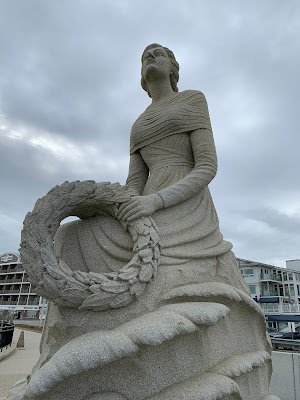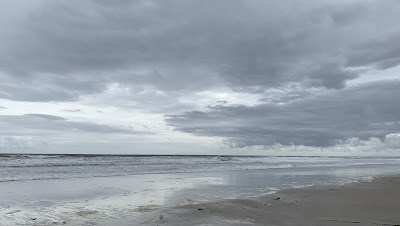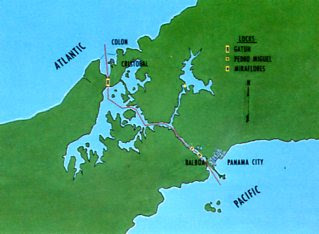On
the first day of my retirement, I left town and travelled to Skagway, Alaska. This was not a convenient place to
reach. I left Boston at 6:00am on
Saturday, October 19, 2024, on Air Canada, changed aircraft in Toronto and
Vancouver, and flew into Whitehorse, the capital of the Yukon Territory. Following a roller coaster flight through
wild turbulence over the Rocky Mountains, the diminutive airplane touched down
in a snow-saturated landscape at 5:00pm.
My son James met me at the Whitehorse airfield. After dinner in a local restaurant, we made
the two-hour drive through the mountains of the Yukon, northwestern British
Columbia, and southeastern Alaska to Skagway and sea level. My objective in travelling to this remote
location was to spend several days visiting James and seeing his excursion
trains and cruise ships.
Skagway sits at the head of navigation on the Lynn Canal. Not really a canal at all, this body of water is one of the many fjords and bays that comprise the Inside Passage, a network of inland waterways that stretches from Washington through British Columbia to Alaska and is sheltered from the open Pacific by a series of islands and peninsulas. Long an important route for commercial shipping, the Inside Passage is now frequented largely by cruise ships and ferries. Many of these stop at Skagway, the place where the shipping lines and the railroad meet.
James’ employer, the White Pass and Yukon Route, operates excursion trains for the cruise ship passengers. These trains embark everyone at the docks downtown and then run “up the hill” on a line that climbs mountains, skirts river gorges, ducks through tunnels, crosses bridges, and delivers the sightseers to scenic spots in British Columbia and the Yukon. The entire route is tremendously scenic, and therein lies the appeal to folks on vacation. After several hours of sightseeing aboard the trains, the railroad returns the passengers to the docks in Skagway, and there they rejoin their cruise ships and put to sea again.
As a guest of the White Pass, I had the privilege of riding these trains and sitting up front in the locomotive with James at the controls. This made for a fascinating series of journeys up the hill and back down again, and to both the cruise ship piers downtown and the railroad shops at the edge of town. It was late in the tourist season, however, and instead of lush foliage in the mountains, there lay a thick carpet of snow with walls of icicles clinging to the rocks. It was a very impressive and truly beautiful landscape; nonetheless, I still felt drawn to the waterfront, and I found it just as appealing.
The mountains and the sea together formed my favorite part of the landscape. Two worlds met at the Skagway waterfront; it was a confluence of geology and oceanography and a place of breathtaking beauty. Little wonder that so many people sailed there to see it. My first view of this waterfront took place on Sunday afternoon, October 20. Watching from an empty cruise ship pier, James and I witnessed the arrival of the ferry Hubbard of the Alaska Marine Highway from Juneau. I took a sequence of photographs of this event, and I’m happy to present the best ones here:
There were no cruise ships in port that day, nor on the Monday following, but the Norwegian Bliss of the Norwegian Cruise Line arrived on Tuesday the 22nd, and I was able to take one good picture of her. The weather had changed by this time. It was snowing along the railroad in the mountains, but raining at sea level, and so here we see the Norwegian Bliss through the rain:
The next day, Wednesday the 23rd, saw the arrival of the Norwegian Jewel, also of the Norwegian Cruise Line. The rain and snow had stopped by this time, but a strong and bitterly cold wind was blowing instead, and this made photography challenging. Nonetheless, I was able to capture a few views of the Norwegian Jewel at her berth:
In this last photograph of the port side amidships, we see how modern cruise ships can resemble high-rise apartment buildings ashore instead of traditional transoceanic passenger liners. A bold new concept in sea travel, cruising has proven tremendously popular with vacationers.
Wednesday was the last day of cruise ship and excursion train operations in Skagway. The vacation season of 2024 thus drew to a close. The ships sailed south to a warmer climate, and Skagway hunkered down for the winter. James and I left town and made the long drive through the Yukon and the Alaskan interior to Anchorage, where I would enjoy a two-and-a-half-weeks-long visit with my son Steven and my granddaughters Miss Katie and Miss Abby. Memories of Skagway and its trains and ships would remain with me, though, and so in parting I present some views of the White Pass Route.
First,
this locomotive reposed on a passing siding in a spot called Glacier[1] on Tuesday the 22nd,
as it waited for a passenger train to come by on the main track:
Not far from the tunnel this massive rock wall sported an impressive collection of icicles formed by a succession of daily freeze-thaw cycles, also on Wednesday the 23rd:
Finally,
the unofficial railroad photographer, Rod Jensen, took this picture of James
and me alongside the main line in a spot called Gulch on the same Wednesday as the
excursion train operations were winding down for the season:
As both a seaport and a railroad town, Skagway provided an exciting start to my retirement. Even at my age, it was clearly not too late for new destinations and new adventures. Surpassing these opportunities, however, was the priceless gift of time spent with a beloved son in his special element, and this would soon be amplified by time spent with another beloved son and two beloved granddaughters in Anchorage.
For
all of this I was very grateful and also mindful of the scriptural injunction to
“live in thanksgiving daily, for the many mercies and blessings which he hath
bestowed upon you” (Alma 34:38).
[1] James possesses an encyclopedic knowledge
of the makeup and operations of the White Pass.
In response to my simple request for the name of the place where this
siding is located, he informed me that “It runs from milepost 12.7 to 14.1,
it’s 7,400 feet long. It was lengthened
by a mile in 2019.”
[2] Once again from James’ remarks:
The short tunnel is at MP 15.9. The bridge is a wood trestle which was built
in the winter of 1898-1899. The area has
no official name although informally the bridge crosses “Glacier Gorge” and the
tunnel runs through “Tunnel Mountain.”

















































